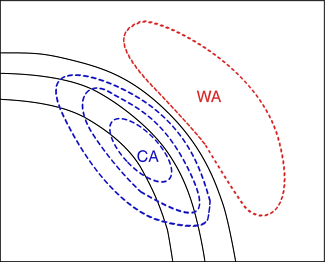Typical Appearance In Vertical Cross Sections
Cross sections for different types of occluded fronts are presented for example in the chapter Occlusion: Warm Conveyor Belt Type (see Occlusion: Warm Conveyor Belt Type - Key Parameters ). In this chapter only those parameters that indicate the process of bending back are mentioned.
- Isentropes:
In the beginning the isentropes show the structure of an Occlusion. It turns into a structure of a Cold Front during the process. - Temperature advection:
In the beginning the vertical structure of temperature advection shows a distribution typical for an Occlusion. If the Back Bent Occlusion turns into a Cold Front, which is the most usual case, it can be seen in the change of the distribution of temperature advection.
The process in which a warm occluded front turns into a Cold Front can be seen from a sequence of cross sections:
A Warm Occlusion:
|
17 June 2001/18.00 UTC - Vertical cross section; black: isentropes (ThetaE), red thick: temperature advection - WA, red thin:
temperature advection - CA, orange thin: IR pixel values, orange thick: WV pixel values
|
|
A Cold Occlusion:
|
18 June 2001/12.00 UTC - Vertical cross section; black: isentropes (ThetaE), red thick: temperature advection - WA, red thin:
temperature advection - CA, orange thin: IR pixel values, orange thick: WV pixel values
|
|
A Cold Front:
|
19 June 2001/06.00 UTC - Vertical cross section; black: isentropes (ThetaE), red thick: temperature advection - WA, red thin:
temperature advection - CA, orange thin: IR pixel values, orange thick: WV pixel values
|
|





